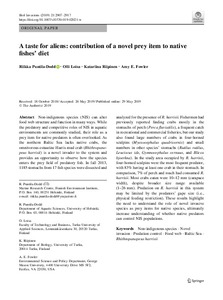A taste for aliens: contribution of a novel prey item to native fishes’ diet
Olli Loisa; Katariina Riipinen; Riikka Puntila-Dodd; Amy E. Fowler
https://urn.fi/URN:NBN:fi-fe2021042825250
Tiivistelmä
Non-indigenous
species (NIS) can alter food web structure and function in many ways.
While the predatory and competitive roles of NIS in aquatic environments
are commonly studied, their role as a prey item for native predators is
often overlooked. As the northern Baltic Sea lacks native crabs, the
omnivorous estuarine Harris mud crab (Rhithropanopeus harrisii)
is a novel invader to the system and provides an opportunity to observe
how the species enters the prey field of predatory fish. In fall 2013,
1185 stomachs from 17 fish species were dissected and analyzed for the
presence of R. harrisii. Fishermen had previously reported finding crabs mostly in the stomachs of perch (Perca fluviatilis),
a frequent catch in recreational and commercial fisheries, but our
study also found large numbers of crabs in four-horned sculpins (Myoxocephalus quadricornis) and small numbers in other species’ stomachs (Rutilus rutilus, Leuciscus ide, Gymnocephalus cernuus, and Blicca bjoerkna). In the study area occupied by R. harrisii,
four-horned sculpins were the most frequent predator, with 83% having
at least one crab in their stomach. In comparison, 7% of perch and roach
had consumed R. harrisii. Most crabs eaten were 10–12 mm (carapace width), despite broader size range available (1–26 mm). Predation on R. harrisii
in this system may be limited by the predators’ gape size (i.e.,
physical feeding restriction). These results highlight the need to
understand the role of novel invasive species as prey items for native
species, ultimately increase understanding of whether native predators
can control NIS populations.
Keywords
Non-indigenous species Novel invasion Predation control Food web Baltic Sea Rhithropanopeus harrisiiKokoelmat
- Rinnakkaistallenteet [19207]
